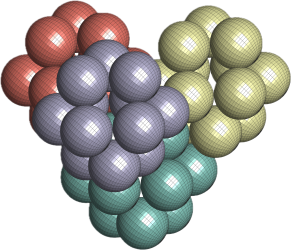Each frame of this simulation showcases the outcomes of Sequential Quadratic Programming (SQP) minimization applied to a Lennard-Jones system. The system’s energy is defined by the following expression:
![Rendered by QuickLaTeX.com \begin{equation*} E_{LJ}=\sum_{\{ A, B \} } \frac{1}{2}\sum_{a \in A} \sum_{b \in B} 4\epsilon\left[\left(\frac{\sigma}{r_{ab}}\right)^{12} - \left(\frac{\sigma}{r_{ab}}\right)^{6}\right] \end{equation*}](https://milotorda.net/wp-content/ql-cache/quicklatex.com-e667e732de97bd4a1f260d50e3bd9bbb_l3.png)
where the parameters are set as ![]() and
and ![]() . Here,
. Here, ![]() represents the ordered pair of molecules
represents the ordered pair of molecules ![]() and
and ![]() . The simulation involves a system of
. The simulation involves a system of ![]() molecules, each comprising
molecules, each comprising ![]() atoms. At the start, a uniform random configuration was generated, with each molecule represented by two center of mass coordinates and one rotational coordinate.
atoms. At the start, a uniform random configuration was generated, with each molecule represented by two center of mass coordinates and one rotational coordinate.
As the simulation progresses, the boundaries of the box are incrementally reduced following each SQP minimization. This effectively simulates an increase in pressure on the system. Notice the hexagonal tiling patches as the simulation advances. These are depicted as blue regular hexagons, each scaled by a factor of 1.93185 and rotated by an angle of 0.17862 relative to the molecules.
It’s important to note that the empty spaces observed in the simulation are a result of the rate at which pressure is increased. A sufficiently slow increase in pressure would eventually lead to a ![]() regular tiling.
regular tiling.
